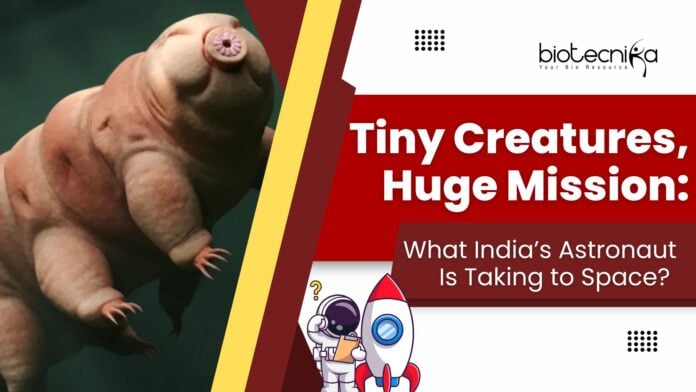Shubhanshu Shukla Voyagers Tardigrades Mission: What India’s Astronaut Is Taking to Space
Indian astronaut Shubhanshu Shukla is on an exciting 15-day mission aboard the International Space Station (ISS), the Voyagers Tardigrades Mission. The entire mission is to understand and observe these tiny organisms called the Tardigrades. Even though they are small, they have a unique feature of surviving in very harsh environments. The Indian astronauts will now explore how they will survive, reproduce, and repair themselves in space. This is not just an ordinary experiment; with the right results, it will drastically improve human space exploration. The research can eventually transform space medicine, genetics, and even cryopreservation.
Shubhanshu Shukla, the first privately funded research astronaut, left on June 10th, 2025, with the crew members to experiment on Tardigrades, part of Axiom Mission-4.
This mission is known to follow Rakesh Sharma’s historic journey in 1984, marking India’s comeback to human spaceflight after forty years. In the upcoming days, these seven cutting-edge experiments created by Indian researchers will be part of the next voyage, which is being co-sponsored by NASA, ISRO, and ESA. The groundbreaking research on tardigrades, also known as water bears, is one example.
Why Tardigrades?
Tardigrades are microscopic organisms with eight legs, whose size ranges from 0.5 to 1.5 millimeters. Scientists worldwide have been captivated by their capacity to endure the most extreme conditions, including high pressure, cold temperatures, dehydration, extreme radiation, and even the vacuum of space.
Interesting facts about Tardigrades:
- In 1773, German biologist Johann August Ephraim Goeze discovered tardigrades.
- Their ability to endure temperatures ranging from -272.95°C to 150°C is astounding.
- These creatures can enter a cryptobiotic state, suspending their metabolism to survive extreme conditions for extended periods. This helps them shut down their system completely.
- One of the most interesting facts is that they lose 95% of their water content and attain a dry, shrunken state called ‘Tun’.
The Voyager Tardigrades experiment aims to explore the survival strategies of these organisms in space. Scientists are trying to observe the following features;
- Ability of the Tardigrades to revive from cryptobiosis in microgravity
- Survive and reproduce in space conditions
- Repair DNA damage and respond at the genetic level
The mission aims to understand how tardigrades endure such stresses at the molecular level. Insights from this research could lead to innovations in astronaut health, long-term biological preservation, radiation protection, and even advancements in biotechnology on Earth.
A Few Other Key Experiments on the Mission:
In addition to the tardigrade study, Shukla’s mission includes some more Indian-designed microgravity experiments that address critical aspects of space biology and sustainability. They are as follows;
- Muscle Stem Cell Regeneration
This experiment will explore how muscle stem cells behave in microgravity and whether metabolic supplements can counteract muscle atrophy. It is essential because it involves research that helps understand the concerns for long-duration space missions.
- Space Agriculture
Seeds of moong beans (green gram), fenugreek, and salad greens will be sprouted aboard the ISS. Scientists aim to study their germination, growth, and nutritional content in zero gravity, paving the way for future space-based farming.
- Microalgae and Cyanobacteria Study
Edible microalgae and cyanobacteria from diverse Indian ecosystems, ranging from wastewater to the Himalayas and the Indian Ocean, will be cultured in space. The main reason for selecting these organisms is their ability to produce oxygen and nutrition in closed life-supporting systems.
- Human–Technology Interaction
This experiment will evaluate how astronauts interact with visual displays and control systems in zero gravity. The findings will help optimize the design of onboard interfaces for better safety and usability.
Scientific Significance and Future Impact
This mission represents a critical step in India’s roadmap toward becoming a major player in human space exploration. The collaborative effort between NASA, ISRO, and ESA reflects a growing international recognition of India’s scientific potential in space research.
Researching the adaptations of organisms such as tardigrades to space may result in improved technology for astronaut safety, more effective ways to store biological samples for extended periods, and even bioengineered solutions that imitate these robust characteristics.
Additionally, the outcomes of studies on algae and plant growth may help ensure sustainable food production in future space settlements.
India has big goals, such as launching a lunar expedition by 2040 and building its own space station, the Bharatiya Antariksha Station, by 2035. The knowledge acquired from this mission will substantially contribute to these long-term objectives by confirming the biological, environmental, and technological frameworks required for prolonged space living.
Future Prospects from the Mission:
After completing this mission, the results obtained from the exclusive space exploration will be extensively analysed. The results will be highly informative, not just for India’s Gaganyaan human spaceflight program but also for future human space exploration missions. The mission will provide a detailed overview of how life forms will thrive in extraterrestrial environmental conditions.
This mission is more than a scientific study—it is a testament to India’s evolving capabilities in space technology, life sciences, and international collaboration.























